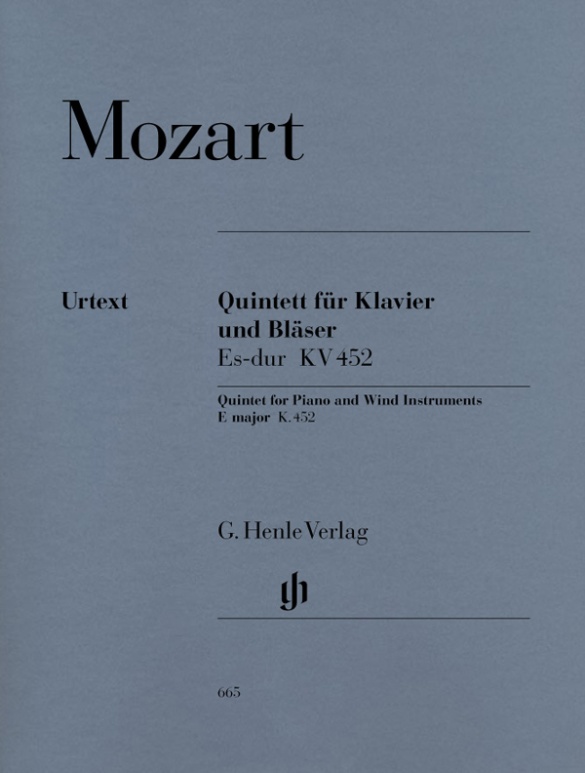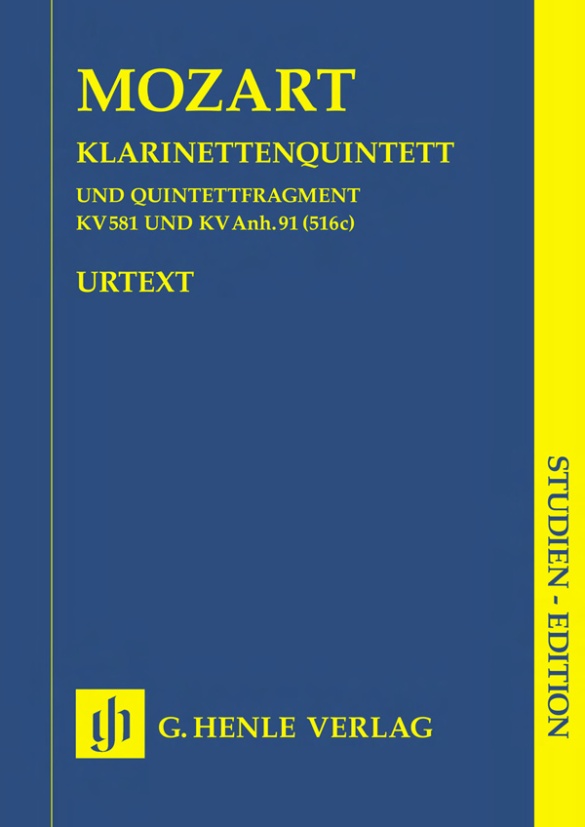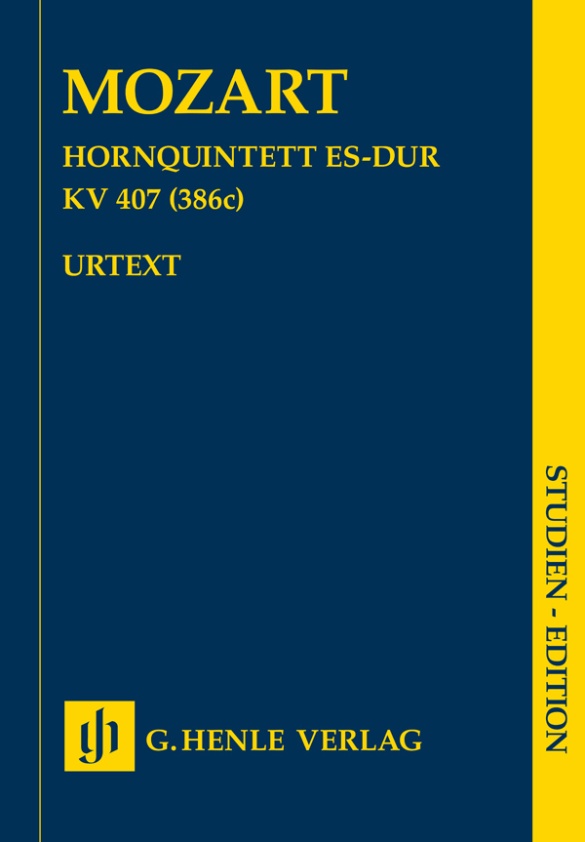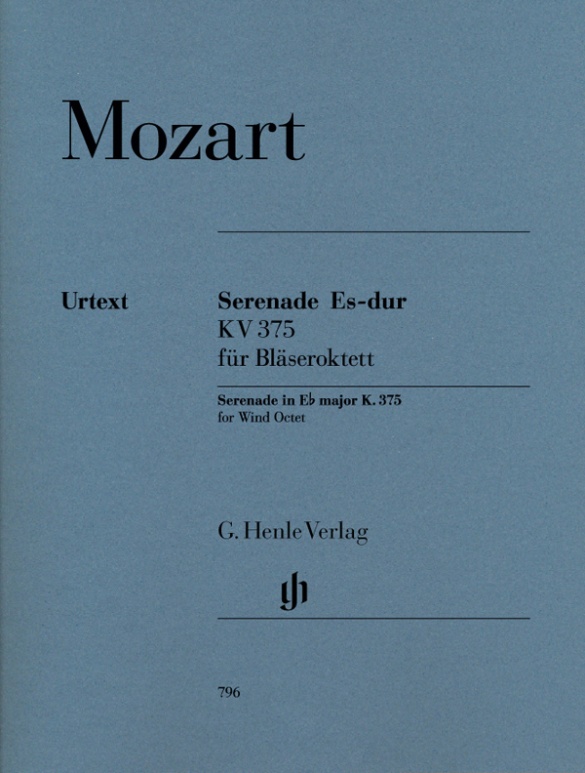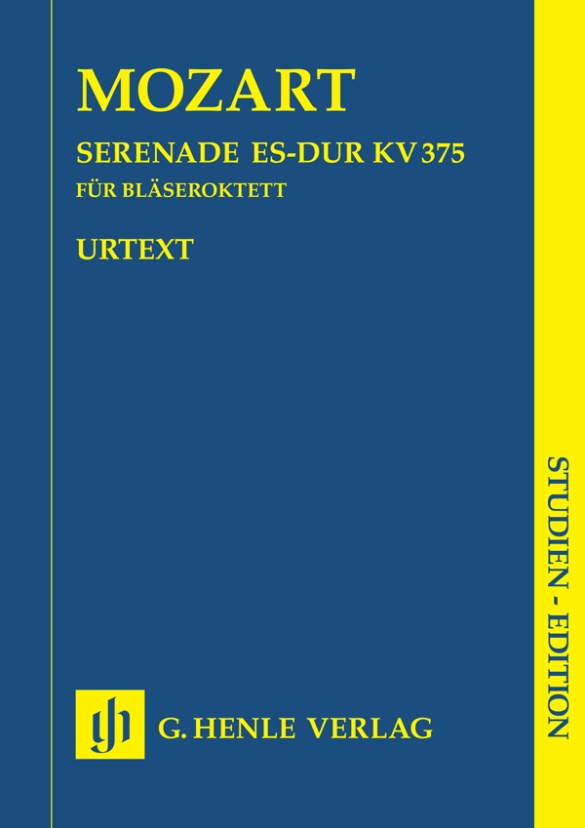Wolfgang Amadeus Mozart
Quintet E flat major K. 452 for Piano, Oboe, Clarinet, Horn and Bassoon
Mozart’s famous statement to his father concerning this unique and singular quintet for piano and winds, scored for piano, oboe, clarinet in B-flat, horn in E-flat, and bassoon, should not be forgotten: “I myself consider it the best thing I have yet written in my life.” The only relevant source for this new Urtext edition is Mozart’s clean and almost error-free autograph score, preserved today at the Bibliothèque nationale in Paris. A page of music with a spurious ending was smuggled into it, a fact revealed (and elucidated) for the first time in the present Henle edition.
内容/詳細
作曲家について

Wolfgang Amadeus Mozart
Mozart is one of the few composers to have produced masterpieces in all genres. On the concert tours he undertook in his early years (London, Mannheim, Italy, Paris) he gained many varied musical impressions that he assimilated in his youth and which formed the prerequisite for his later consummate musical language.
| 1756 | Born in Salzburg on January 27, the son of musician and later court composer Leopold Mozart. His early regimented musical education from his father began in 1761, first compositions at age five. |
| 1763–66 | Extended concert tours through various German cities and to Paris, London, Amsterdam, Switzerland. He composes his first sonatas for violin and piano, K. 10–15, dedicated to Queen Charlotte, as well as the first symphonies from London, K. 16 and 19, which show the influence of the works of Johann Christian Bach and Karl Friedrich Abel (the three-movement Italian sinfonia form). |
| 1767 | Premiere in Salzburg of the sacred light opera “Die Schuldigkeit des ersten Gebotes,” K. 35 (written with Michael Haydn and Anton C. Adlgasser), and the intermezzo “Apollo et Hyacinthus,” K. 38. Journeys with his father and sister to Vienna. |
| 1768 | Probably the premiere in Vienna of his Singspiel “Bastien and Bastienne,” K. 50. Composition of his first masses. |
| 1769 | Performance in Salzburg of the dramma giocoso “La finta semplice,” K. 51. |
| 1769–71 | Two tours to Italy; he meets Farinelli, P. Nardini, and Padre Martini, among others, and, on the second trip, Hasse. Premieres in Milan of his opera seria “Mitridate, Re di Ponto” in 1770 and of the festa teatrale “Ascanio in Alba” in 1771. Composition of symphonies and his first string quartet (1770, K. 80). |
| 1771 | Composition of the oratorio “La Betulia liberate,” K. 118, in Salzburg/Italy. |
| 1772 | Premiere of the serenata drammatica “Il sogno di Scipione,” K. 126, for the accession of Salzburg Archbishop Hieronymus Count Colloredo. He receives an appointment as salaried concertmaster of the Salzburg Court Chapel (of which he had been an unpaid member since 1769). Third journey to Italy with his father, premiere in Milan of the dramma per musica “Lucio Silla,” with general success. The final trip to Italy spells the ends of his youthful phase of appropriation; he has tested out all important instrumental genres (symphony, sonata, string quartet) and all the main genres of opera (Singspiel, opera buffa, opera seria, festa teatrale). |
| from 1773 | Composition of string quartets (K. 168–173) under the influence of Haydn, and of symphonies, divertimenti, serenades. He increasingly devotes himself, contingent upon the duties of his post, to liturgical music; several masses are written. Begins to compose violin and piano concerti. |
| 1775 | Premiere in Munich of the dramma giocoso “La finta giardiniera” and the serenata “Il Rè pastore.” Piano sonatas, K. 279–284. |
| 1777 | He vacates his post temporarily to undertaken a promotional tour with his mother to Munich, Mannheim, and Paris. |
| 1778 | Composition of the “Paris” Symphony in D major (K. 297). In Paris he experiences the quarrel between the proponents of Gluck and those of Piccinni. Publication of violin sonatas. |
| 1779 | Resumes his duties in Salzburg, as court organist. Coronation Mass in C major. |
| 1781 | Premiere in Munich of his tragédie lyrique “Idomeneo,” in which French and Italian elements are synthesized. Journey to Vienna. After his falling out with the Archbishop of Salzburg, he gives up his post, moves to Vienna, and earns his living as a free composer through concertizing and giving music lessons. His last great period of creativity begins. |
| 1782 | He becomes acquainted with the works of Bach and Handel through Baron van Swieten; after this he arranges Bachian fugues and incorporates the “learned style” (fugues and counterpoint) into his works beside the “galant style” (e.g. in the String Quartet in G major, K. 387, in 1782; Piano Sonata in F major, K. 533, in 1786; the Jupiter Symphony, K. 551, in 1788; “Die Zauberflöte” (“The Magic Flute”), and the Requiem in D minor, K. 626, both in 1791). Premiere in Vienna of his Singspiel “Die Entführung aus dem Serail” (“The Abduction from the Seraglio”). Composition of the Haffner Symphony in D major, K. 385. |
| 1783 | Mass in C minor, K. 427; Linz Symphony in C major, K. 425. |
| 1784 | Hunt Quartet in B-flat major, K. 458. |
| 1785 | Premiere in Vienna of the oratorio “Davide penitente,” K. 469. “Dissonance” Quartet in C major, K. 465. |
| 1786 | Premiere of the comedy with music “Der Schauspieldirektor” (“The Impresario”), K. 486, which Salieri’s competing work “Prima la musica e poi le parole” (“First the Music and Then the Words”) bests. Premiere in Vienna of the opera buffa “Le nozze di Figaro” (“The Marriage of Figaro”), whose extended action-packed finales form a highpoint of opera buffa. Prague Symphony in D major, K. 504. |
| 1787 | Serenade in G major (“Eine kleine Nachtmusik”), K. 525. He is named imperial and royal chamber composer. Premiere in Prague of the dramma giocoso “Il dissoluto punito ossia Il Don Giovanni,” a synthesis of serious and comic opera. |
| 1788 | Composition of the large Symphonies in E-flat major, K. 543; G minor, K. 550; and C major (Jupiter Symphony), K. 551. Clarinet Quintet in A major, K. 581. |
| 1790 | Premiere in Vienna of the dramma giocoso “Così fan tutte ossia La scuola degli amanti.” |
| 1791 | Premiere in Prague of the opera seria “La clemenza di Tito” and in Vienna of the Singspiel “Die Zauberflöte.” Clarinet Concerto in A major, K. 622. The Requiem remains unfinished. Dies in Vienna on December 5. |
校訂者や運指担当者について

Wolf-Dieter Seiffert (校訂)
Dr. Wolf-Dieter Seiffert, born in 1959 in Frankfurt/M., read musicology, modern German literature, and philosophy at the Ludwig-Maximilians-Universität in Munich. On a scholarship from the “Studienstiftung des Deutschen Volkes”, he did his doctorate in 1990 with a thesis on “Mozarts frühe Streichquartette” (Rudolf Bockholdt). That same year, Seiffert started work at G. Henle Publishers as an editor. Parallel to his work at the publisher, he completed a diploma in business studies at the St. Gallen University, KMU-HSG, financed by the Günter Henle Foundation. Seiffert was managing director of G. Henle Verlag from 2000 to 2023.
Seiffert has edited numerous Urtext editions for G. Henle Publishers, predominantly on Mozart’s works.

Klaus Schilde (運指)
Prof. Klaus Schilde, born in 1926, spent his childhood in Dresden. There he was greatly influenced by Walter Engel, who taught him the piano (Kodaly method), composition and violin. From 1946–1948 he studied at the music conservatory in Leipzig with Hugo Steurer. After moving to the west in 1952 he studied with Walter Gieseking and Edwin Fischer, as well as with Marguerite Long, Lucette Descaves and Nadia Boulanger in Paris.
Schilde won numerous prizes. From 1947 onwards he gave concerts as a soloist and chamber musician on almost every single continent with renowned orchestras. He taught at the music conservatories in East Berlin Detmold, West Berlin, Munich, Tokyo (Geidai) and Weimar. From 1988–1991 he was President of the Staatliche Hochschule für Musik und Theater in Munich, where he also taught for decades as a professor. There are numerous radio and television broadcasts with Klaus Schilde as well as CD recordings. Schilde has contributed fingerings to almost 100 Henle Urtext editions.
Prof. Klaus Schilde passed away on 10 December, 2020.
製品安全に関する情報

G. Henle Verlag
製品の製造元に関する情報はこちらでご覧いただけます。G. Henle Verlag
Forstenrieder Allee 122
81476 München
info@henle.de
www.henle.com
Accurata edizione Urtext del Quintetto KV 452 di Mozart basata sulla versione manoscritta dell’autore, unica fonte veramente attendibile...
Hortus Musicus... Darum sollte Musikkritik unmißverständlich gute Ausgaben gut, mangelhafte aber schlecht nennen. Die Mozart-Ausgaben des Henle-Verlags, von denen hier eine Auswahl der jüngsten Produktion angezeigt wird, gehören allesamt zu den guten.Vom einstigen Lektor, dem inzwischen zum Verlagsleiter aufgestiegenen Wolf- Dieter Seiffert stammen die Editionen der beiden gewichtigsten Kammermusikwerke dieser Reihe, des Klavierquintetts KV 452 und des Divertimentos KV 563. Ersterer liegt das Autograph zugrunde, das in der Pariser Nationalbibliothek aufbewahrt wird, letztere folgt in Ermangelung einer mozartschen Eigenschrift dem postumen Erstdruck im Wiener Artaria-Verlag von 1792. Für die Gründlichkeit der investierten Quellenarbeit spricht im Falle des Quintetts die Einsicht, daß die alternative Schlußversion des Stücks, bislang (auch in der NMA) als von Mozart stammend angesehen, eine Fälschung darstellt (wer das Material im Original kennt, kann den Befund nur bestätigen). Dem Divertimento ist das Fragment eines G-Dur- Streichtrios beigegeben, an dem die Praxis zumindest das Vergnügen einer ausgearbeiteten Satzexposition finden mag, freilich auch die Enttäuschung eines unvermittelten Abbruchs nach wenigen Durchführungstakten erleben muß. Wer weniger an den Spielmaterialien und mehr an Partituren zum Studiengebrauch interessiert ist, der sollte beim Quintett und Divertimento (samt Fragment) zur jeweiligen Studien-Edition im vergrößerten Taschenformat greifen. Textidentisch mit den ,großen' Ausgaben, eröffnen die beiden Bände eine bequeme (und wohlfeile) Möglichkeit des eingehenden analytischen Studiums der Noten. ... Alle Ausgaben enthalten Vorworte mit knappen Abrissen der jeweiligen Entstehungs- und Überlieferungsgeschichte; bei den Kammermusikwerken sind außerdem Bemerkungen zur Textgestalt beigegeben. Fazit: Diese "taubenblauen Urtexte" sollten den Weg auf viele Notenpulte finden!
Acta MozartianaDas sehr übersichtlich gestaltete Notenmaterial, in dem auch Fingersätze für den Klavierpart eingefügt sind, ist außerdem mit Bemerkungen bezüglich der Anpassungen an das Autograph versehen. Möge die neue Druckausgabe viele Interpreten zur Erarbeitung dieses reizvollen Werkes ermutigen!
Clarinoおすすめ
autogenerated_cross_selling
このタイトルを含む他の版
このタイトルを含む他の版


